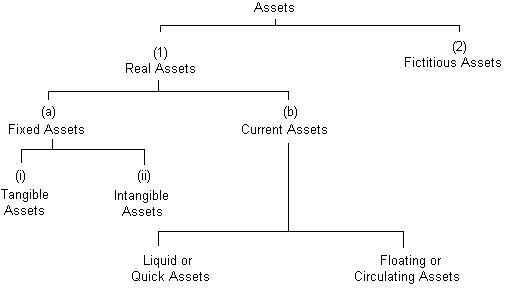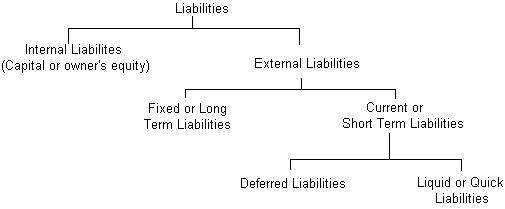|
Asset |
$ |
Liabilities and
Capital |
$. |
| |
|
|
|
Assets may
be classified as follows:

Real Assets:
Assets
which have some market value are called real assets,
e.g. building, machinery, stock, debtors, cash,
goodwill, etc. Real assets are further divided into two
types according to their permanence:
Fixed Assets:
Assets which have long
life and which are bought for use for a long period of
time are called "fixed assets". These are not bought for
selling purposes, e.g. land, building, plant, machinery,
furniture etc. Fixed assets are again sub-divided into
two:
-
Tangible Assets: Assets which have physical
existence and which can be seen, touched and felt
are called "tangible assets", e.g. building, plant,
machinery, furniture etc.
-
Intangible Assets: Assets which have no
physical existence and which cannot be seen, touched
or felt are called "intangible assets", e.g.
goodwill, patent right, trade mark etc.
Current
Assets: Assets which are short-lived and which can be
converted into cash quickly to meet short term
liabilities are called "current assets", e.g. stock
debtors, cash etc. Such assets change their form
repeatedly and so, they are also known as circulating
or floating assets. For example, on purchase of
goods cash is converted into stock and on sale of goods,
stock is converted into debtors, on collection from
debtors, debtors take the form of cash etc.
Out of
current assets those which can be converted into cash
very quickly or which are already in the form of cash
are called liquid or quick assets e.g. debtors,
cash in hand, cash at bank etc.
Fictitious Assets:
Assets which have no market value are called
fictitious assets. examples of fictitious assets
include preliminary expenses, loss on issue of shares
etc. They are also known as nominal assets.
Besides
these, there is another type of assets whose value
gradually reduce on account of use and finally exhaust
completely. This type of assets is called wasting assets
e.g. mine, forest etc.

Internal Liabilities:
The total amount of debts payable
by a business to its owner is called internal liability
e.g. Owner's equity (capital), reserve etc. From
practical view point internal liabilities should not be
regarded as liabilities, since there is no question of
meeting such liabilities al long as the business
continues.
External Liabilities:
All debts payable by a
business to the outsiders (other than the owner) are
called external liabilities e.g. creditors, debentures,
bills payable, bank overdraft, etc. External liabilities
are further divided into two.
Fixed or Long Tern
Liabilities: The liabilities which are payable after
a long period of time are called fixed or long term
liabilities e.g. debentures, loan on mortgage etc.
Current or Short Term
Liabilities: The debts which are repayable within a
short period of time are called current or short-term
liabilities e.g. creditors, bills payable, bank
overdraft etc. Current liabilities may again be divided
into two:
-
Deferred Liabilities: Debts which are repayable
in the course of less than one year but more than
one month are called deferred liabilities e.g. Short
term loan etc.
-
Liquid or Quick Liabilities: Debts are repayable
in the course of a month are called liquid or quick
liabilities e.g. bank overdraft, outstanding
expenses, creditors etc.
Besides
the above, there is another type of liability which is
known as contingent liability. It is one
which is not a liability at present, but which may or
may not become a liability in in future. It depends upon
certain future event. For example, suppose, the buyer of
goods filed a suit in the court against the seller
claiming damage of $10,000 for breach of contract. This
will be regarded as a contingent liability to the seller
until the receipt of the court's order. To the buyer,
this is a contingent asset. Both contingent liability
and contingent asset are not recorded in the balance
sheet. They are generally mentioned in the balance sheet
as a note.
As we have
discussed that the main purpose of balance sheet is to
disclose a true and fair financial position of a
business on a particular date. So, the assets and
liabilities must be shown in such a manner that the
financial position of the business can be assessed
through it easily and quickly. Thus an arrangement is
made in which assets and liabilities are shown in the
balance sheet. Such an arrangement is called marshaling
of assets and liabilities. There are three methods of
marshaling:
-
Permanency Preference Method
-
Liquidity Preference Method
-
Mixed
Method
These
methods of preparing a balance sheet are briefly
explained below:
Permanency Preference Method:
Under this
method, the assets and liabilities are shown in balance
sheet in the order of their permanence. In other words,
the more permanent the assets and liabilities, the
earlier are they shown. This method is adopted by joint
stock companies and under this method the balance sheet
will take the following form:
Balance Sheet as
at.....
|
Assets |
$ |
Liabilities |
$ |
|
Fixed Assets:
Good will
Patent
Land
Building
Plant & Machinery
Furniture & Fixtures
Current
Assets:
Investment
Stock
Sundry debtors
Bills receivable
Prepaid expenses
Liquid
Assets:
Cash at bank
Cash in hand |
|
Fixed Liabilities:
Capital
Reserves
Long term loans
Current
Liabilities:
Sundry creditors
Bills payable
Bank overdraft
Outstanding expenses |
|
Liquidity Preference Method:
Under this
method, assets and liabilities are shown in order of
their liquidity. The more liquid the assets, the earlier
are they shown. The sooner the liabilities are to be
paid off, the earlier are they shown. This method is
adopted by sole proprietorship and partner ship
business. Under this method the form of balance sheet
is:
Balance Sheet as
at.....
|
Assets |
$ |
Liabilities |
$ |
|
Liquid Assets:
Cash at bank
Cash in hand
Current
Assets:
Investment
Stock
Sundry debtors
Bills receivable
Prepaid expenses
Fixed
Assets:
Good will
Patent
Land
Building
Plant & Machinery
Furniture & Fixtures |
|
Current
Liabilities:
Sundry creditors
Bills payable
Bank overdraft
Outstanding expenses
Fixed
Liabilities:
Capital
Reserves
Long term loans |
|
(Liquidity preference method is exactly reverse of the
first method)
Mixed Method:
Under this
method, assets are shown in the order of permanence and
liabilities are shown in order of liquidity. This method
is adopted by banks and insurance companies etc.